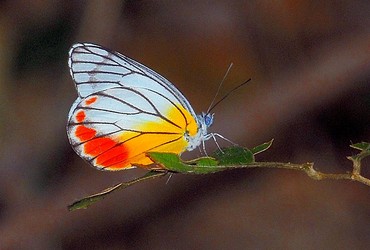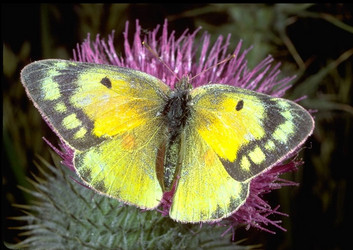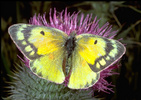Pieridae
Andrew V. Z. Brower


This tree diagram shows the relationships between several groups of organisms.
The root of the current tree connects the organisms featured in this tree to their containing group and the rest of the Tree of Life. The basal branching point in the tree represents the ancestor of the other groups in the tree. This ancestor diversified over time into several descendent subgroups, which are represented as internal nodes and terminal taxa to the right.

You can click on the root to travel down the Tree of Life all the way to the root of all Life, and you can click on the names of descendent subgroups to travel up the Tree of Life all the way to individual species.
For more information on ToL tree formatting, please see Interpreting the Tree or Classification. To learn more about phylogenetic trees, please visit our Phylogenetic Biology pages.
close boxThe current hypothesis of relationships for pierid genera is based upon the molecular phylogenetic hypothesis of Braby et al. 2006. Taxa not included in that hypothesis are indicated as incertae sedis as indicated by the authors, and the inferred positions of several fossil pierid genera are also indicated.
Introduction
Pieridae are the sulphurs and whites, medium-sized mostly pale-colored butterflies with a world-wide distribution. There are some 1100 species.
Nomenclature
The name Pieridae is attributed to Duponchel, 1835, in the Official List of Family Names, but J. Pelham (pers. comm.) points out that Swainson employed the name for a family-level group some 15 years prior, and argues that priority should be observed.References
Ackery, P. R., R. de Jong, and R. I. Vane-Wright. 1999. The butterflies: Hedyloidea, Hesperioidea, and Papilionoidea. Pages 264-300 in: Lepidoptera: Moths and Butterflies. 1. Evolution, Systematics, and Biogeography. Handbook of Zoology Vol. IV, Part 35. N. P. Kristensen, ed. De Gruyter, Berlin and New York.
Braby, M. F. 2005. Provisional checklist of genera of the Pieridae (Lepidoptera: Papilionidae). Zootaxa 832:1–16.
Braby, M., R. Vila, and N. E. Pierce. 2006. Molecular phylogeny and systematics of the Pieridae (Lepidoptera: Papilionoidea): higher classification and biogeography. Zoological Journal of the Linnean Society 147(2):239-275.
Bridges, C. A. 1988. Catalogue of Papilionidae and Pieridae (Lepidoptera: Rhopalocera). Urbana, Illinois: Charles A. Bridges.
Lamas, G. 2004. Pieridae. In: Lamas G, ed. Checklist: Part 4a Hesperioidea–Papilionoidea. In: Heppner JB, ed. Atlas of Neotropical Lepidoptera, Vol. 5A. Gainesville: Association for Tropical Lepidoptera/Scientific Publishers, 99–117.
Pollock, D. D., W. B. Watt, V. K. Rashbrook, and E. V. Iyengar. 1998. Molecular phylogeny for Colias butterflies and their relatives (Lepidoptera: Pieridae). Annals of the Entomological Society of America 91(5):524-531.
Stavenga, D. G., S. Stowe, K. Siebke, J. Zeil, and K. Arikawa. 2004. Butterfly wing colours: scale beads make white pierid wings brighter. Proceedings of the Royal Society of London B 271:1577–1584.
Title Illustrations

| Scientific Name | Delias hyparete |
|---|---|
| Location | Lower Peirce, Singapore |
| Specimen Condition | Live Specimen |
| Source | Painted Jezebel |
| Source Collection | Flickr |
| Image Use |
 This media file is licensed under the Creative Commons Attribution License - Version 2.0. This media file is licensed under the Creative Commons Attribution License - Version 2.0.
|
| Copyright | © 2007 Jwee |
| Scientific Name | Colias eurytheme |
|---|---|
| Location | Bear River Ridge Road (Humboldt County, California, USA) |
| Comments | Alfalfa butterfly |
| Creator | T. W. Davies |
| Specimen Condition | Live Specimen |
| Source | Colias eurytheme; Alfalfa butterfly |
| Source Collection | CalPhotos |
| Copyright |
© 1999 California Academy of Sciences

|
About This Page
Andrew V. Z. Brower

Middle Tennessee State University, Murfreesboro, Tennessee, USA
Correspondence regarding this page should be directed to Andrew V. Z. Brower at
abrower@mtsu.edu
Page copyright © 2009 Andrew V. Z. Brower
 Page: Tree of Life
Pieridae .
Authored by
Andrew V. Z. Brower.
The TEXT of this page is licensed under the
Creative Commons Attribution License - Version 3.0. Note that images and other media
featured on this page are each governed by their own license, and they may or may not be available
for reuse. Click on an image or a media link to access the media data window, which provides the
relevant licensing information. For the general terms and conditions of ToL material reuse and
redistribution, please see the Tree of Life Copyright
Policies.
Page: Tree of Life
Pieridae .
Authored by
Andrew V. Z. Brower.
The TEXT of this page is licensed under the
Creative Commons Attribution License - Version 3.0. Note that images and other media
featured on this page are each governed by their own license, and they may or may not be available
for reuse. Click on an image or a media link to access the media data window, which provides the
relevant licensing information. For the general terms and conditions of ToL material reuse and
redistribution, please see the Tree of Life Copyright
Policies.
- Content changed 15 November 2009
Citing this page:
Brower, Andrew V. Z. 2009. Pieridae . Version 15 November 2009 (under construction). http://tolweb.org/Pieridae/12176/2009.11.15 in The Tree of Life Web Project, http://tolweb.org/









 Go to quick links
Go to quick search
Go to navigation for this section of the ToL site
Go to detailed links for the ToL site
Go to quick links
Go to quick search
Go to navigation for this section of the ToL site
Go to detailed links for the ToL site